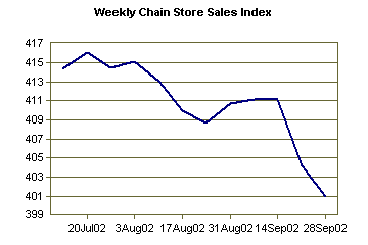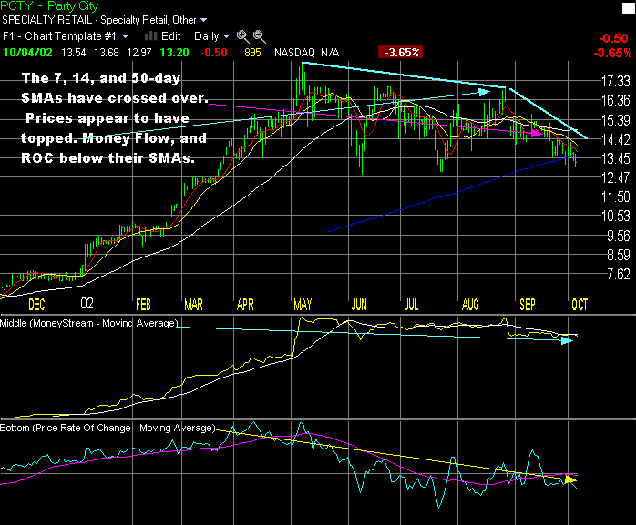Cloudy With A Chance Of Double Dip
Market Trend:
Down
Market Outlook:
Cautiously Bearish
Sectors Long:
None
Sectors Short:
None
Media Watch:
Barron’s Vs. IBD
Macroplay of the
Week: The Party’s Over
Portfolio Bias:
Cash to Short
The Broad Market Outlook
Mounting war clouds, a faltering consumer, ostrich business executives,
profligate politicians, and an increasing chance of double-dip recession.
That’s the stock market’s bearish forecast for the economy, and it’s way past
time for both investors and policymakers to take heed.
War Clouds:
Forget the “war is good for the economy” rhetoric. The problem with an Iraqi
one is that it is taking much too long to get to the battlefield. The result is
a prolonged oil-price shock of at least $6 per barrel for the global
economy, that has no end
in sight. Shave at least a half point off the GDP right there.
A
Faltering Consumer:
Like the little Dutch boy with his finger in the dike, the resilient American
consumer — whose spending generates two-thirds of the GDP — has been
holding up the economy. That may well end soon for several reasons, among them:
-
First, with the aforementioned mounting
war clouds and rising recessionary fears, cautious consumers are putting more
money under the proverbial mattress than into what will (too) soon be our
Holiday-decked malls. Moreover, paying the “Iraqi war premium†at the gas pump
is acting as a consumption tax. That’s a zero sum game between OPEC sheiks and
America’s retailers. -
Second, the nation’s mortgage-refinancing
boom has heretofore provided a bountiful source of consumption spending.
Indeed, instead of taking advantage of lower interest rates to lower mortgage
payments, many refinancing consumers have simply kept payments the same and
simply taken large sums of equity cash out. Now, with interest rates scraping
bottom and many opportunities already realized, the re-fi boom is showing signs
of exhaustion. That means if consumers want to splurge, they are going to have
to do it the old-fashioned way — with more credit-card debt.
Note: Foreclosures and bankruptcies are
mounting amidst America’s ever-leveraged consumers. Never a good sign, either.
Ostrich
Executives:
During the Great Depression, economist John Maynard Keynes opined that
the problem was the “animal spirits†of business executives. These fearful
bears simply refused to undertake capital expenditures at a time they believed
the economy was heading into the trash can. Of course this was, in many ways, a
self-fulfilling prophecy.
We’ve got a similar problem today as most
CEOs only take their heads out of the sand long enough to issue another earnings
warning and lower projection for capital spending. These pronouncements are
sucking more life out of the market — particularly the tech sector — than any
vampire ever got out of a body.
Profligate
Politicians:
In a post 9/11 world that augurs a prolonged war on terrorism and substantial
increases in both defense spending and homeland security, we are looking at a
decade of budget deficits. Earth to Congress: Deal with this in a fiscally
responsible way instead of going about your pre-election merry spending ways!
Better yet, come to understand that the single most important reason that the
Federal Reserve did NOT lower interest rates at its last
TWO meetings when it
clearly should have, is because Chairman Alan Greenspan fears that fiscal policy
is way over-stimulative and will eventually be recessionary.
As for why such an “over-stimulativeâ€
fiscal stimulus hasn’t revived the economy yet, it simply works much more slowly
than monetary policy. That’s why Greenspan views the Bush-Congress budget more
as a ticking inflationary time-bomb than an appropriate discretionary policy
tool.
The Market’s
Bottom Line: The weekly flow of macroeconomic data from
both the consumption and production sides of the economy, coupled with corporate
earnings warnings, weakening consumer confidence, and teetering consumer credit,
continues to paint a picture of the economy replete with Dancing Bears. The
stock market is reacting accordingly, and yes, the market CAN go even lower than
the latest “Houdini bottom†it appears to have reached. (Remember: A Houdini
market is one with many false bottoms that make your money disappear.)
Accordingly, if you are an investor, keep
your money in cash. If you are an active trader, consider the short side. More
broadly from a policy perspective, we can only hope that the local Iraqi bus
soon turns into an express.
The silver lining here is that
successfully “liberating†Iraq’s oil fields — the second-largest reserves in the
world — would, over time, likely break OPEC’s stranglehold on prices and the
world economy. That would certainly set the stage for our next bullish wave
of prosperity.
The Week’s Macro Data
Market Movers:
The Macroeconomic Calendar
|
|
|
|
Monday |
|
|
|
|
|
|
|
|
|
|
|
|
|
* Potential major
market movers in red
A
slow data week in a downward-trending market offers little hope for a
rally-spurring upside surprise. The big game to watch this week doesn’t really
start until Friday when we get a double dose of consumption news.
The risk for Retail Sales is to the downside — look for a lower-than-expected
number to really hammer the markets, particularly if it comes with another dip
in Consumer Sentiment.
Because of the mixed message we got last week on the unemployment numbers, watch
Jobless Claims carefully. (Our take on the UE numbers is that they were BAD.
Yes, the unemployment rate went down unexpectedly but the data cognoscenti know
that the payroll data, which was negative, is more reliable than the UE data.)
Finally, one picture is worth a thousand double dips. Take a look at this chart
of chain–store sales and if you’ve been sitting on retail stocks, read it and
weep.

Media Watch
Fascinating little
point-counterpoint in Barron’s vs. IBD this week on the
unemployment numbers: Barron’s Gene Epstein continues to tout recovery,
while launching a frontal assault on the Gore-Daschle-New York Times
How to Lie With Statistics Conspiracy. Epstein pooh-poohs the idea that the
unemployment numbers show anything other than a moderate recovery.
On the other hand, IBD’s Christina Wise on
the front page contrasts the reliability of the payroll vs. UE numbers and
uses analysts’ comments to paint a far gloomier picture. Although Epstein is
always interesting to read, we side with IBD on this one. Stay tuned.
Macroplay of the Week:
The Party’s Over (PCTY)
I just can’t get excited
about any particular stocks in this market. It is simply too volatile. That’s
why I’m sticking primarily with cash and the Cubes, eliminating sector AND
company risk. If you still want to trade in a specific stock, check out this
recommendation by my partner David Aloyan. It’s based on sound technical
analysis but is also consistent with the faltering consumer macrowave discussed
above:
“Shortâ€
Party City
(
PCTY |
Quote |
Chart |
News |
PowerRating)
which is in the weak Specialty Retail
Sector. The daily chart below of Party City shows prices have closed below
their 200-day SMA on Friday. Prices appear to have put in a topping formation
with the 7,14, and 50-day SMAs crossed over to the downside. Money Flow,
and the ROC momentum indicators are below their simple moving averages.

If you have a favorite macroplay or stock you would like us to consider in this
column, send an e-mail to
peter@peternavarro.com or go directly to
https://www.peternavarro.com. We’d love to hear from you.
